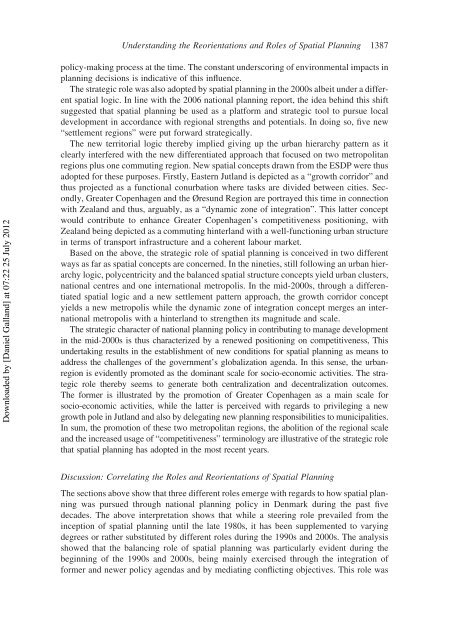Galland EPS 2012 - VBN
Galland EPS 2012 - VBN
Galland EPS 2012 - VBN
Create successful ePaper yourself
Turn your PDF publications into a flip-book with our unique Google optimized e-Paper software.
Understanding the Reorientations and Roles of Spatial Planning 1387<br />
Downloaded by [Daniel <strong>Galland</strong>] at 07:22 25 July <strong>2012</strong><br />
policy-making process at the time. The constant underscoring of environmental impacts in<br />
planning decisions is indicative of this influence.<br />
The strategic role was also adopted by spatial planning in the 2000s albeit under a different<br />
spatial logic. In line with the 2006 national planning report, the idea behind this shift<br />
suggested that spatial planning be used as a platform and strategic tool to pursue local<br />
development in accordance with regional strengths and potentials. In doing so, five new<br />
“settlement regions” were put forward strategically.<br />
The new territorial logic thereby implied giving up the urban hierarchy pattern as it<br />
clearly interfered with the new differentiated approach that focused on two metropolitan<br />
regions plus one commuting region. New spatial concepts drawn from the ESDP were thus<br />
adopted for these purposes. Firstly, Eastern Jutland is depicted as a “growth corridor” and<br />
thus projected as a functional conurbation where tasks are divided between cities. Secondly,<br />
Greater Copenhagen and the Øresund Region are portrayed this time in connection<br />
with Zealand and thus, arguably, as a “dynamic zone of integration”. This latter concept<br />
would contribute to enhance Greater Copenhagen’s competitiveness positioning, with<br />
Zealand being depicted as a commuting hinterland with a well-functioning urban structure<br />
in terms of transport infrastructure and a coherent labour market.<br />
Based on the above, the strategic role of spatial planning is conceived in two different<br />
ways as far as spatial concepts are concerned. In the nineties, still following an urban hierarchy<br />
logic, polycentricity and the balanced spatial structure concepts yield urban clusters,<br />
national centres and one international metropolis. In the mid-2000s, through a differentiated<br />
spatial logic and a new settlement pattern approach, the growth corridor concept<br />
yields a new metropolis while the dynamic zone of integration concept merges an international<br />
metropolis with a hinterland to strengthen its magnitude and scale.<br />
The strategic character of national planningpolicyincontributingtomanagedevelopment<br />
in the mid-2000s is thus characterized by a renewed positioning on competitiveness, This<br />
undertaking results in the establishment of new conditions for spatial planning as means to<br />
address the challenges of the government’s globalization agenda. In this sense, the urbanregion<br />
is evidently promoted as the dominant scale for socio-economic activities. The strategic<br />
role thereby seems to generate both centralization and decentralization outcomes.<br />
The former is illustrated by the promotion of Greater Copenhagen as a main scale for<br />
socio-economic activities, while the latter is perceived with regards to privileging a new<br />
growth pole in Jutland and also by delegating new planning responsibilities to municipalities.<br />
In sum, the promotion of these two metropolitan regions, the abolition of the regional scale<br />
and the increased usage of “competitiveness” terminology are illustrative of the strategic role<br />
that spatial planning has adopted in the most recent years.<br />
Discussion: Correlating the Roles and Reorientations of Spatial Planning<br />
The sections above show that three different roles emerge with regards to how spatial planning<br />
was pursued through national planning policy in Denmark during the past five<br />
decades. The above interpretation shows that while a steering role prevailed from the<br />
inception of spatial planning until the late 1980s, it has been supplemented to varying<br />
degrees or rather substituted by different roles during the 1990s and 2000s. The analysis<br />
showed that the balancing role of spatial planning was particularly evident during the<br />
beginning of the 1990s and 2000s, being mainly exercised through the integration of<br />
former and newer policy agendas and by mediating conflicting objectives. This role was
















